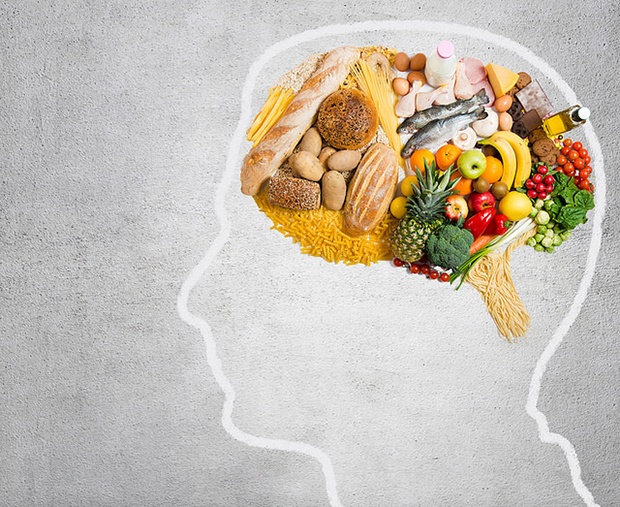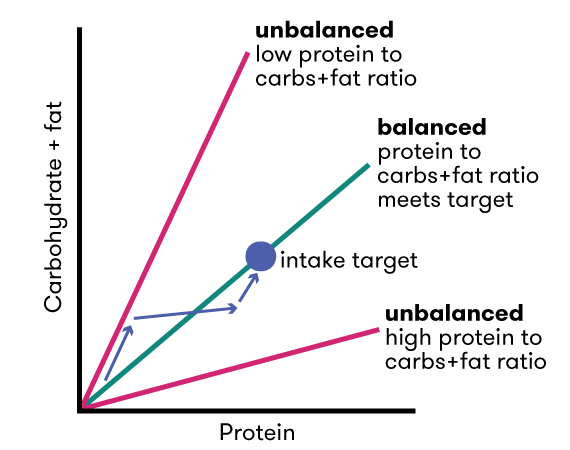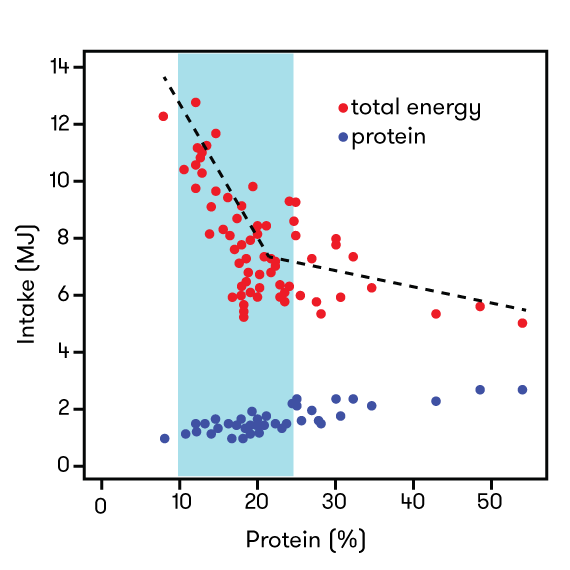What is a balanced diet, anyway?
Expert reviewers
Essentials
- The balance of macronutrients (protein, fat and carbohydrate) in the diet profoundly affects appetite and performance in all animals.
- Multiple experiments have shown that several different types of animals can balance their intake of protein, fat and carbohydrate.
- According to the protein leverage theory, the proportion of protein in the diet will control the total amount of food eaten—animals, including humans, tend to keep eating until they’ve reached their specific protein target.
- The optimal dietary macronutrient balance will be different for different people, and during different stages of life.
When it comes to diet these days, it can be bewildering. There’s so much marketing and hype and every week there’s a different celebrity spruiking a new fad diet—we can cut out carbs, or we could try and go back to our cavewoman origins. Or perhaps just stop eating for one day every week. But who should we listen to and what should we do? What does the actual science say?
Let’s start at the beginning. We need energy for our bodies to function, and we get our energy from our food. Generally, we talk about our food in terms of the amount of nutrients it contains. Among these are the micronutrients like vitamins and minerals—things that are very important to our health, but we only need tiny amounts of them. Then there are the big guns that yield our energy and are the major building blocks needed to support healthy cell growth and development, the macronutrients: protein, carbohydrates, and fats.

The fundamental macronutrients: protein vs. carbs+fat
Let’s look at a simple representation of our diet in terms of the macronutrients—the protein, carbohydrates and fat—that we consume to meet our energy needs.
For now, we will split them into two groups: protein (that yields nitrogen as well as energy), and carbs+fat (mainly energy-yielding). If we then make a chart, with protein on the x-axis, and carbs+fat on the y-axis, we can talk about the ‘nutrient space’ of our dietary needs, and plot a ‘target’ that reflects how much protein and carbs+fat we need.

Foods also can fit into this nutrient space, according to their protein and carbs+fat content. Foods can be represented by lines in the nutrient space. When you eat a particular food, you travel along that line. Foods that take you directly to your target = nutritionally balanced! Foods that don’t take you to your target = unbalanced. Generally, our diet consists of a combination of unbalanced foods that eventually ‘balance out’, getting us to our target within the macronutrient space. The average human diet consists of around 15 per cent protein, with the rest of the energy requirements coming from carbs+fat.
So, just how important is this target? Is it arbitrary—merely a coincidence that all human diets end up having a very similar proportion of protein vs. carbs+fat? One way scientists discover new knowledge, and try to answer interesting questions, is to conduct experiments that might shed light on the answers, or at least take them part way there. Let’s have a look at a range of experiments conducted by researchers all trying to disentangle the relationship of protein vs. carbs+fat. And we’ll start with … cockroaches.
So, nutritional targets are important in cockroaches. What about other animals?
Cockroaches, baboons … that’s all very well. But as humans, we’re more complicated, driven more by tastes and a gastronomic quest for exquisite flavour, right? Let’s see…
Right, so we have evidence indicating that some animals—cockroaches, baboons, and humans—are very consistent at regulating their diets to achieve their optimal amounts of protein vs. carbs+fat. The next question is, are either of these macronutrient groups more important than the other? If for some reason an animal can’t get the optimal amount of both, does one get priority?
Will an animal prioritise its carbs+fat target, eating a certain amount of carbs+fat and not worrying if the protein target is met? Or will the protein target be the more important goal? Or neither?
Turns out, in some animals at least, it’s mainly about the protein.
The power of protein
So the crickets were tramping across the countryside for days on end purely in search of protein. The quest for protein is relentless, and the stakes are high: if a cricket stops moving, it becomes an easy source of protein for its companions, and it will be eaten. When given abundant protein, enough to satisfy their appetites, the crickets don’t eat each other, and they stop swarming.
Now, there are some additional elements to this study that let us pull out some more sophisticated conclusions. In the forest where the orangutans lived, there is lots of variation in the availability of fruit. There are some occasions of extremely abundant fruit (high carbs+fat), and other times where the orangutans’ diet was restricted to a mixture of fruit and leaves (high protein).
If the results over all the seasons are looked at together, there’s a very striking result: there’s a huge range in the intake of carbs+fat, but a very small window in the range of protein intake. This means that it’s the amount of protein that the orangutans are consuming that determines the overall amount of food they eat—if they’re eating predominantly high protein foods, they don’t eat as much food in total. But if the food is high in carbs+fat but low in protein, they eat more of it. This is because they really want to eat a desired amount of protein—getting to their protein target is an important priority for the orangutans. This is called protein leverage—a theory that the protein content of an animal’s diet exerts influence or leverage over the total energy intake.
During times of high fruit abundance, the orangutans tended to eat much more carbs+fat, while still maintaining the same protein level. When fruit was scarce, they under-consumed carbs+fat, yet still met their protein target. When these results were examined alongside the biochemical markers found in the orguntans’ wee, the scientists found some more interesting results.

When the orangutans consumed lots of fruit (and therefore carbs+fat), levels of C-peptide were high. C-peptide is associated with lipogenesis, which is when an animal puts on body fat. Conversely, high levels of ketones, which are associated with the break-down or loss of body fat (lipolysis), were found during the times when fruit was scarce and the orangutans were not eating so much carbs+fat. This shows how the orangutans adapt their diet and go through a cycle of gain and loss of body fat according to their external environment. The protein leverage theory suggests that the wild orangutans’ food intake—both the types and amounts of foods they eat—ensures they always meet their protein requirements, but other metabolic functions, such as the gain and loss of body fat, are controlled by external ecological circumstances.
So, what about us? Do humans show a similar mechanism of protein leverage? Yup, we sure do.
All of the typical diets consumed by human populations around the world contain somewhere between 10 and 25 per cent protein; usually 15 per cent. Higher protein diets, around 25 per cent, are typical of hunter-gatherer societies, while the lowest per cent protein (10 per cent) has been reported from the Japanese island of Okinawa, where people traditionally live a very long time (more on this below!).

As the protein content of typical human diets increases, the total energy consumed tends to decrease. The shaded area indicates the range of typical human diets.
Adapted from Gosby, A.K., Conigrave, A.D., Raubenheimer, D. and Simpson, S.J. (2014) Protein leverage and energy intake Obesity Reviews 15, 183–191.
If you look at the protein content of human diets as a percentage of the total energy, we can see that the lower protein diets are accompanied by higher total energy—a typical outcome of the protein leverage mechanism. The range of total energy of the diets as protein ranges from 10 to 25 per cent is striking—someone eating a 10 per cent protein diet may end up eating much more than someone eating a diet of 25 percent protein.
And this is the crux of the matter. We really need our protein, and we will keep eating whatever we have at hand until we get it.
So it seems pretty clear. Cockroaches regulate their diet according to protein intake. Crickets crave protein so much they’ll march across the countryside for days in search of it, even turning on and eating each other if they can’t satisfy their protein appetite. Baboons and orangutans regulate their intake of protein and non-protein energy. And we, too, are driven to consume food until we reach a particular sweet spot of protein intake.
How can this help us understand our current problems with obesity?
The typical Western diet has seen a decrease in protein content of around 1–2 per cent since the 1960s. There are a few reasons behind this.
Firstly, protein can be more expensive than fats and carbs—you can see this by just looking at foods in the supermarket. The foods like meat and fish, with a high protein content, are generally more expensive (although there are sources of vegetable protein that are cheaper!).
There’s an evolutionary component too. Back in the early days of human evolution, fats and sugars were rare and prized, and our biology rewarded us for seeking them out. Now they’re superabundant, and act as supernormal stimuli. We like them, so we eat lots of them. The highly processed junk foods—known as ultra-processed foods—that are common in Western diets cater specifically to this. They contain lots of fat and lots of sugar, diluting the protein content. These foods, made of primarily industrial ingredients and little in the way of whole foods, taste good if we get used to their flavour, and are cheap and convenient. As a society, we’re eating more and more of them.

The problem is, unlike the fruit in the orangutans’ diet, which is only abundant in certain seasons, ultra-processed foods are readily available all year-round: our ecological environment doesn’t exert any control over the make-up of our energy intake. Plus, they’re cheap, marketed heavily, convenient and designed to be ultra-tasty. So it’s all too easy to eat them, and in striving to meet our bodies’ protein target, we eat lots and lots of them, completely over-consuming carbs and fats along the way.
So from all of these studies comes a striking message: protein is important. A balanced diet is one that meets an animal’s protein target, and if our diet is low in protein we will eat more overall in order to reach our magic protein target. This goes a long way to explaining why some of the more successful fad diets out there actually have some impact on weight loss: the proportion of protein to carbohydrates and fat result in a more satisfying experience.
But hold on! Don’t abandon your bread, pasta and fruit in favour of an all tofu, meat and bean diet just yet. Too much protein is actually bad for you. Humans can’t survive on a diet of more than 40–50 per cent protein.
The Australian Dietary Guidelines recommend that we eat ‘a wide variety of nutritious foods’ and in doing so, obtain 15–25 per cent of our energy from protein, 45–65 per cent from carbohydrate and 20–35 from fats. It’s also important to note that all the human experiments discussed here have had adult subjects. The dietary requirements of growing infants and children are very different.
Furthermore, maintaining a healthy, non-obese weight is not the only measure of health. Let’s go back to the experimental drawing board…
Different diets for different outcomes
But flies are somewhat two-dimensional: their macro-nutrient space really only consists of carbs and protein (fat is needed, but only in tiny amounts). What about mice, where fat is another macro-nutrient that we have to throw into the mix?
And what about us? Can these findings about mice be extrapolated to humans? Well, the science is not yet conclusive, but there are studies emerging that suggest a low protein, high carb diet in our middle and later years is more beneficial than a high protein diet.
The upshot of this short journey through the scientific method and these various experiments is that different diets have different impacts. While a high-protein, low-carbs+fat diet appears to be the best for achieving weight loss and maintaining a healthy body weight, it might not be so good for us as we enter our old age, where lower-protein, high-carb diets seem to promote a longer lifespan, albeit at the risk of increased body fat. Different macronutrient compositions of a diet optimise different aspects of health, and which aspect we might choose to optimise will change according to a variety of factors.
But have we really come all this way through all this scientific evidence without a single piece of advice for people to cling to come New Year resolution time? The reason for this should be clear from the results of all the studies: there is no such thing as a one-size-fits-all ‘balanced’ diet that is good for everyone, at every stage of life. However, as recommended in the Australian Dietary Guidelines, there are a few simple things we can all hold on to: eat sensibly, eat whole foods and avoid excessive consumption of ultra-processed foods. If you drink alcohol, do so in moderation. Evolution has spent a long time refining the way we subconsciously determine our nutrient intake—we need get back in tune with the nutritional wisdom of our bodies and appetites.





